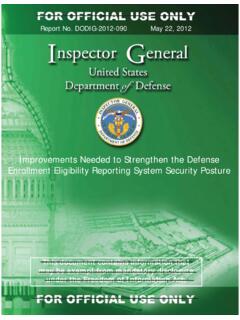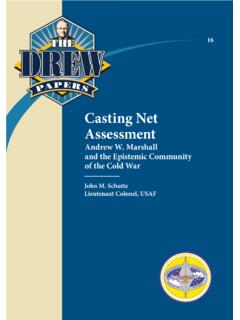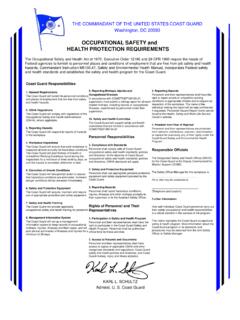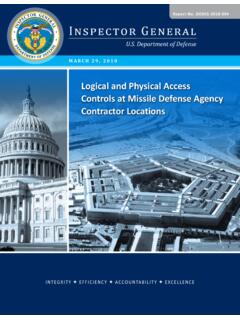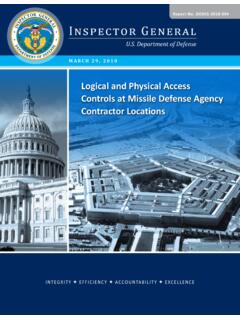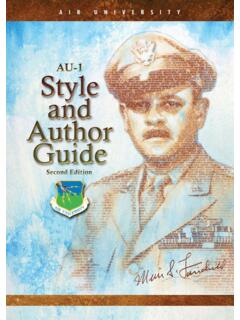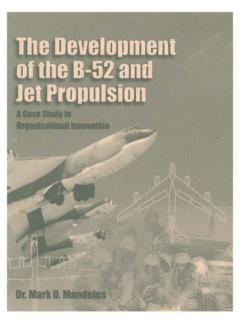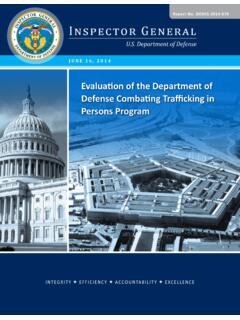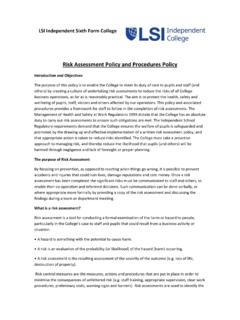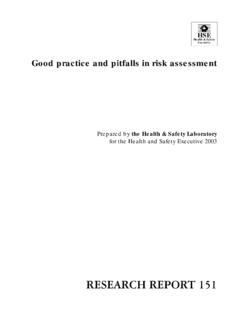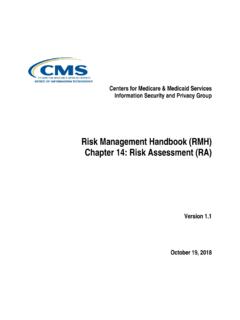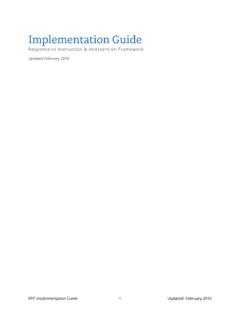Transcription of Port Operations Checklists and Risk Assessment
1 1 AE Pam 385-15-3 4 Mar 19 Headquarters United States Army Europe Wiesbaden, Germany Headquarters United States Army Installation Management Command Europe Sembach, Germany Army in Europe Pamphlet 385-15-3* 4 March 2019 Safety Port Operations Checklists and Risk Assessment *This pamphlet supersedes AE Pamphlet 385-15-3, 25 November the Commander: HARTMUT H. RENK Brigadier General, GS Chief of Staff Official: SCOTT T. CHANCELLOR Chief, Army in Europe Document Management Summary. This pamphlet provides port Operations Checklists and a generic port Operations risk Assessment . This pamphlet must be used with AE Pamphlet 385-15. Summary of Change. This revision Replaces references to the Military Traffic Management Command (MTMC) with references toSurface Deployment and Distribution Command (SDDC).
2 Modifies Checklists and risk assessments used by personnel conducting port Operations (tables 2through 4).Applicability. This pamphlet applies to leaders in Army elements who are planning or conducting port Operations in the USAREUR area of Operations . Records Management. Records created as a result of processes prescribed by this pamphlet must be identified, maintained, and disposed of according to AR 25-400-2. Record titles and descriptions are on the Army Records Information Management System website at If the Back button of your browser is not visible, use ALT + Back Arrow to return to previous location. 2 AE Pam 385-15-3 4 Mar 19 Suggested Improvements. The proponent of this pamphlet is the USAREUR Safety Division (mil 537-3092).
3 Users may send suggested improvements to this pamphlet by e-mail to the USAREURS afety Division at This pamphlet is available only electronically and is posted in AEPUBS at CONTENTS References3. Explanation of Abbreviations4. Introduction5. Checklists and Tables6. Port-to-Fort OperationsTables s s Checklist4. Port Operations Risk AssessmentGlossary purpose of this pamphlet is to enable leaders to plan or conduct port Operations in the USAREUR area of Operations with minimum risk to personnel and equipment. This pamphlet must be used withAE Pamphlet 25-400-2, The Army Records Information Management System (ARIMS). Pamphlet 385-15, Leader s Operational Accident-Prevention Pamphlet 385-15-1, Commanders Convoy Checklist and Risk Pamphlet 385-15-2, Commanders Rail Operations Checklist and Risk EXPLANATION OF ABBREVIATIONSThe glossary defines the Back button of your browser is not visible, use ALT + Back Arrow to return to previous location.
4 3 AE Pam 385-15-3 4 Mar 19 Seaports are traditionally busy, congested, and confusing places. As vehicles arrive at the seaport,port personnel will give them a quick, visual inspection to identify those with obvious problems and scan the Logistics Application of Automated Marking and Reading Symbols (LOGMARS) label. Vehicles carrying hazardous and sensitive cargo will be separated from the rest of the vehicles and sent to the hazardous-and sensitive-cargo staging areas. The other vehicles will be sent to the vehicle staging areas to be rechecked and have LOGMARS labels rescanned. b. Drivers and assistant drivers will be sent out of the staging areas to an assembly area for Vehicles must arrive at the time specified in the port message, and everyone must know what to dowhen the vehicles arrive.
5 5. Checklists AND TABLESL eaders and drivers planning or conducting port Operations will use the appropriate table (a through dbelow) to help them assess hazards and risks . The glossary defines abbreviations used in the 1, Leader s 2, Driver s 3, Port-to-Fort 4, Port Operations Risk PORT-TO-FORT OPERATIONSO perations at a seaport of debarkation (SPOD) can be divided into the following phases:a. Ship Arrival. The keyword during this phase is flexibility. Ship arrival time is approximate. Afterthe ship arrives, it takes time to tie it up. After that, customs officials and other agents must inspect the ship and clear the cargo for entry into the country. Consequently, cargo will not be immediately ready for pickup when the ship arrives.
6 (1) As a rule of thumb, off-load Operations will begin one-half to a full day after the ship movement officers should use the checklist in table 3, part I, to ensure the unit is ready for off-loading. (2) In preparation for the ship s arrival, the transportation officer can obtain a copy of the vessel-load papers from the Surface Deployment and Distribution Command (SDDC). From these papers, unit movement officers can then determine the unit, type, and condition of cargo, and the type and location of hazardous cargo before the vessel arrives. Off-loading can then proceed properly and safely. If the Back button of your browser is not visible, use ALT + Back Arrow to return to previous location. 4 AE Pam 385-15-3 4 Mar 19 b.
7 Off-Loading. A ship off-load operation resembles a cattle drive on the verge of a stampede. Thisis the most dangerous part of ship Operations , and everyone working in or near the port must remain alert. Vehicles will be moving out of the ship quickly; stevedore gangs will be in all the holds unleashing vehicles; tank engines will fill holds with noise and exhaust fumes, even though the ship s blowers will be operating at maximum capacity. In this busy, hot, noisy, smelly environment, everyone must give safety top priority. Table 3, parts II and III, lists items to check during the off-load phase of port Operations . c. Staging of Cargo. Staging occurs at the same time as the off-load phase. Cargo will be parked byunit in the road-march staging area, and by type and trainload in the rail-staging area.
8 Vehicle movement into the staging areas is rapid, but the transportation terminal unit (TTU) will have laid out the staging areas, and ground guides will direct vehicles into the proper lanes. Table 3, part IV, lists items to check during this phase of the operation. d. Departure of Cargo from the Terminal by Road, Rail, or Air. Only after SPOD staging areasare filled should convoy commanders allow their drivers into the staging areas. It is a safety hazard to have drivers milling around before the staging-area operation is complete, because of the off-loaded cargo rapidly filling the area at the same time. Before departure, TTU reception teams must scan LOGMARS labels for accountability of Army vehicles. (1) The staging area is not the place to reconfigure convoys for road march.
9 Convoy commandersshould coordinate with the TTU for the location of an area to form up in road-march order. Convoy commanders should also ensure every driver and leader receives a road-march safety briefing. AE Pamphlet 385-15-1 provides Checklists for convoy Operations . (2) Rail load-out will begin when the train arrives and the cars are placed on the Pamphlet 385-15-2 provides rail Operations Checklists . If the Back button of your browser is not visible, use ALT + Back Arrow to return to previous location. 5 AE Pam 385-15-3 4 Mar 19 Table 1 Leader s Checklist ITEM TO CHECK CHECK Is there enough drinking water available?(Estimate 1 day at the terminal, although actual time should be less.) Has the unit s terminal-control plan (including the following items) been explained to drivers and supervisoryteams?
10 Assembly points for drivers and other unit personnel after parking their vehicles. Water-point locations. Latrine locations. Trashcan locations for MRE packages and other waste. Has emphasis been placed on unit integrity (keeping everyone together or knowing where theyare) and NCO control? Has the unit key-control officer coordinated with port operators on availability and location of portkey-control NCOs and officers?(If possible, get a radio from TTU to communicate with key-control personnel.) Have soldiers been informed of how they will depart the terminal, and when and where they willbe ported? After all soldiers are assembled, is there a check team to inspect the unit s vehicles formistakes, oversights, items left behind, shackles, and radios left on?
